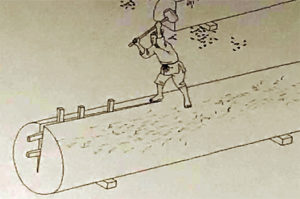

木材製材の歴史で「大鋸〜おが」は14〜15世紀室町時代に中国から導入された。
大鋸は長さが約2メートルあり2人がかりで左右あるいは上下から
縦挽きに挽いて木材を切る。木材建材の生産能率が飛躍的に上昇した。
竹中大工道具館展示では、法隆寺以降の時代について
この製材革命を持って打ち割製材から「挽き割製材」への画時代としている。
それまでの製材方法は「打ち割り」製材と呼ばれるもので、
以前紹介した竹中大工道具館イラスト展示では以下のようだった。

上の写真は千葉県の「国立歴史民俗博物館」展示のものです。
打ち割製材では切り倒した木材の「筋目」に沿って楔を入れて
木槌を振り下ろして、割って製材としていた。その結果、
構造材として利用しやすいのは、杉などの割りやすい材が中心であって、
利用地と伐採地の距離が遠隔化し材の供給に問題が生じていたに違いない。
この製材現場の実態が、日本の木造技術の進化にとって障害になっていた。
割りやすい木を採取し尽くすと供給が乏しくなっていった。
司馬遼太郎エッセイでも日本の大型木造建築の時代的増減に触れた件があり
大型木造建築が旺盛な奈良期から室町期まで減少するとされている。
司馬さんは原材料が伐採され尽くした結果、森林回復にそれくらい掛かった、
という説を上げていたけれど、どうもこの大鋸導入以前の状況だったと思われる。
四天王寺・法隆寺から東大寺・各地の国分寺建設などで
木造技術者は全国に拡散したけれど、やがてこの製材のボトルネックが生じた。
その結果、大規模建築が時代的に減少したのではないだろうか。
竹中大工道具館展示説明でも、木材の樹種がこの大鋸によって
飛躍的に多様化していって各地の身近な山から製材出荷が可能になった。
やはり打ち割り製材では手間が掛かりすぎ、かつ樹種の制約もあったのだ。
そして各地域の人口拡大、経済規模の拡大に沿って支配権力の拡散も、
戦国時代=地域活性化として現実化していった。
各地域の武力権力者は軍事拠点としての城砦建築を活発化させたけれど、
この「大鋸」革命によって構造材生産が幾何級数的に拡大したのだろう。
戦国期の戦争は同時に土木建築の競争でもあったのだと思われる。
武田信玄の甲州の産金とその土木技術の軍事転用や
墨俣の一夜城や高松城の水攻めなどの奇想天外な土木建築活用の秀吉など、
こうした製材革命による木材の大量利用が歴史の影で進行したのだと思う。
ジオラマ展示にはそういう民族的革命事態が暗示されている。
室町期の大鋸の輸入と兵器としての鉄砲輸入は日本史の重要な変化。
鉄砲はより大きく取り上げられるけれど、大鋸もそれ以上だったと思う。
戦争が活発化するのと各地で攻防のための築城は同時進行した。
当然、活発な用材の供給実態が想像されるけれど、
このことについての調査研究活動はあまり注目されていない。
秀吉の巨大な土木建築活用の実態などを見ると、
この「革命」のインパクトをまざまざと実感させられるのだけれど。・・・
English version⬇
[Muromachi period “Daigiri-Oga” sawmill revolution big bang / Japanese good house ㊳-11]
In the history of lumber lumber, “Daigiri-Oga” was introduced from China during the Muromachi period in the 14th and 15th centuries.
Daigiri is about 2 meters long and requires two people from the left and right or from above and below.
Cut the wood by grinding it vertically. The production efficiency of timber building materials has increased dramatically.
At the Takenaka Carpentry Tools Museum exhibition, about the era after Horyuji Temple
With this lumbering revolution, we are in the era of painting from split sawing to “grinding sawing”.
The lumbering method up to that point was called “splitting” lumbering.
The illustration exhibition at Takenaka Carpentry Tools Museum introduced earlier was as follows.
The photo shows the exhibition at the “National Museum of Japanese History” in Chiba Prefecture.
In split lumber, insert a wedge along the “streaks” of the cut down wood.
I shook the mallet down and broke it to make lumber. as a result,
Most of the materials that are easy to use as structural materials are easy-to-break materials such as cedar.
There must have been a problem with the supply of lumber due to the remote distance between the land used and the logging area.
The reality of this sawmill was an obstacle to the evolution of Japanese wooden technology.
When all the fragile trees were collected, the supply became scarce.
Ryotaro Shiba’s essay also touched on the changes over time in large-scale wooden architecture in Japan.
It is said that the number of large wooden buildings will decrease from the Nara period, when it was flourishing, to the Muromachi period.
Mr. Shiba took so much time to reforest as a result of logging being exhausted.
However, it seems that the situation was before the introduction of this Daigiri.
From Shitennoji / Horyuji to Todaiji / Kokubunji in each area
Wooden engineers spread all over the country, but eventually a sawn bottleneck arose.
As a result, the number of large-scale buildings may have decreased over time.
Even in the explanation of the Takenaka Carpentry Tools Museum exhibition, the wood species are selected by this Daigiri.
It has become dramatically diversified, and it has become possible to ship lumber from familiar mountains in each region.
After all, it took too much time and effort to use split lumber, and there were restrictions on the tree species.
And as the population of each region expands and the scale of the economy expands, the power of control also spreads.
It became a reality as the Warring States period = regional revitalization.
Powerful people in each region activated the castle construction as a military base,
This “Daigiri” revolution may have expanded the production of structural materials geometrically.
It seems that the war during the Warring States period was also a competition for civil engineering and construction.
Takeda Shingen’s Koshu gold production and military diversion of its civil engineering technology
Hideyoshi, who utilizes the strange civil engineering architecture such as Sunomata’s Ichiya Castle and Takamatsu Castle’s water attack, etc.
I think that the mass utilization of timber due to this lumber revolution has progressed in the shadow of history.
The diorama exhibition implies such an ethnic revolution.
Imports of large saws and guns as weapons during the Muromachi period are important changes in Japanese history.
The guns are taken up more widely, but I think the Daigiri was even more.
As the war intensified, the construction of castles for offense and defense proceeded at the same time.
Of course, you can imagine the actual supply of active lumber,
Research activities on this matter have received little attention.
Looking at the actual situation of Hideyoshi’s use of huge civil engineering buildings,
You can really feel the impact of this “revolution” …
Posted on 8月 10th, 2021 by 三木 奎吾
Filed under: 住宅マーケティング, 日本社会・文化研究, 歴史探訪







コメントを投稿
「※誹謗中傷や、悪意のある書き込み、営利目的などのコメントを防ぐために、投稿された全てのコメントは一時的に保留されますのでご了承ください。」
You must be logged in to post a comment.